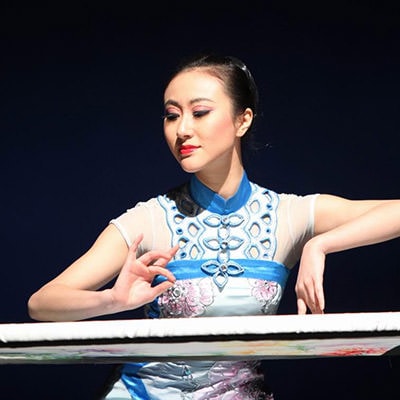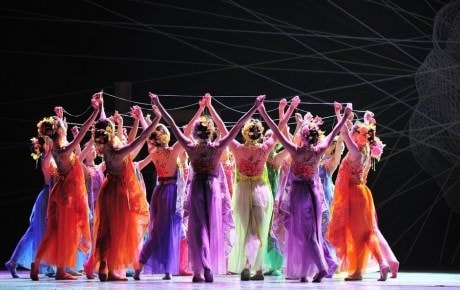Last night the Kennedy Center Opera House hosted The Embroidery Girl, undertaken by the China Wuxi Performing Arts Group, and the Agis Center for Arts and Humanities. There was a substantial turnout of the Chinese-American community as well as other arts lovers and ballet fan.
The group has presented many ambitious and acclaimed large scale dance pieces, at home and abroad, focusing on the Yangtze River. The latest program, The Embroidery Girl premiered in 2011 in China, and then went on tour.

The time period represented in the final years of the Qing Dynasty and the early years of the Republic of China. Telling a tragic love story of a girl said to have mastered Suzhou Embroidery, and a painter named Ming Zuan, the dance/drama portrays a romantic heroine who together with her artist beau, fights against the feudal ethical code, and pursues her liberation from bondage as a concubine and captive of an arranged marriage.
The production was recognized with the Outstanding Drama Award at the 7th Jiangsu Music and Dance Festival. Featured artists are Yashu Zhang, Chenglong Tang, Xin Liu, and Xia Mi. Music for The Embroidery Girl is by Zou Hang, with choreography by Jien Zhang.
Zhang Jiwen is the recipient of multiple awards for stage design in China. The stage design here was a spectacular tour de force, capitalizing on the imagery of embroidery and stitchery displaying in many different ways the warp and web of the embroidery process, using grids and streamers and threads to suggest tabernacles, palaces, and even to imprison the lovers. There was a terrific use of perspective in the backdrop, easily communicating dramatic scale, depth, and distance through grids, shrinking horizons, and geometric patterns, suggesting majestic vistas, architectural details, pomp, and luxurious display of wealth.
Likewise, no expense or attention was spared when addressing costumes, and Li Ruiding’s designs ranged from identifiably Chinese clothing reflecting the character’s status, or military employment to flamboyant dresses apparently made of multicolored and multilayered organza, complete with bustles.
Although this was a tragedy, the performance was broken up with occasional small pieces done with wit and charm with three or four. Otherwise, the stage and the choreography incorporating large groups, something over 40 performers at a time, undertaking complicated synchronized movements, sometimes with screens depicting embroidered works of art. There were several dances which could have stood alone, including a piece in which the dancers worked with string in a sort of “cat’s cradle,” once again exploiting metaphors derived from sewing. One of the interesting elements was a chorus line, perhaps intended as a “Greek Chorus” of performers all wearing identical masks displaying iconic sad expressions.
The lighting design was gorgeous with spotlighting of characters a swell as color shifts which helped to establish a surrealistic and fantastical mood. The music was especially composed for this production and telegraphed the ecstasy and agony experience by the characters. At times, I was not sure what instruments were being used, the music source not being apparent, and although I finally concluded I was hearing stringed instruments, at times it seemed to me that the source was a human vocalizing.
Artistic Director and Choreographer Zhao Ming utilizes a style combining western ballet, modern dance, and Chinese traditional and modern dances. Although I am referring to the dance as a ballet, there were no toe shoes in evidence.
Tang Chenglong played the overbearing and Philistine husband including exciting leaps and gymnastic tumbles reflecting his physical dominance and rage. The embroidery girl, played by Zhang Yashu, was appealing and portrayed alternative states of despair, artistic sublimation, and romantic passion. When her husband takes a second wife, played as an arrogant and cruel displacer by Mi Zia, the embroidery girl’s life, barren of love and affection, is telegraphed by the contrasting demeanor of the two women. Liu Xin plays the artist who becomes infatuated with his female counterpart and tries to save her from her sad fate. He is able to give the embroidery girl the gift of hope, but it is truly her art which ultimately offers meaning to her life.

The Embroidery Girl was a stunningly beautiful experience. When it comes to your town you must buy tickets for the entire family.
Running Time: 90 minutes, with one short intermission.




